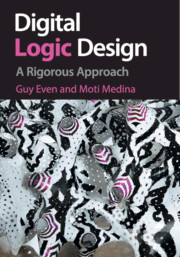Book contents
- Frontmatter
- Contents
- List of Algorithms
- Preface
- PART I PRELIMINARIES
- 1 Sets and Functions
- 2 Induction and Recursion
- 3 Sequences and Series
- 4 Directed Graphs
- 5 Binary Representation
- 6 Propositional Logic
- 7 Asymptotics
- 8* Computer Stories: Big Endian versus Little Endian
- PART II COMBINATIONAL CIRCUITS
- PART III SYNCHRONOUS CIRCUITS
- PART IV A SIMPLIFIED DLX
- Bibliography
- Index
1 - Sets and Functions
from PART I - PRELIMINARIES
Published online by Cambridge University Press: 05 November 2012
- Frontmatter
- Contents
- List of Algorithms
- Preface
- PART I PRELIMINARIES
- 1 Sets and Functions
- 2 Induction and Recursion
- 3 Sequences and Series
- 4 Directed Graphs
- 5 Binary Representation
- 6 Propositional Logic
- 7 Asymptotics
- 8* Computer Stories: Big Endian versus Little Endian
- PART II COMBINATIONAL CIRCUITS
- PART III SYNCHRONOUS CIRCUITS
- PART IV A SIMPLIFIED DLX
- Bibliography
- Index
Summary
This chapter introduces two major notions: sets and functions. We are all familiar with real functions, for example, f (x) = 2x + 1 and g(x) = sin(x). Here the approach is somewhat different. The first difference is that we do not limit the discussion to the set of real numbers; instead, we consider arbitrary sets and are mostly interested in sets that contain only a finite number of elements. The second difference is that we do not define a “rule” for assigning a value for each x; instead, a function is simply a list of pairs (x, y), where y denotes the value of the function when the argument equals x. The definition of functions relies on the definitions of sets and relations over sets. That is why we need to define various operations over sets such as union, intersection, complement, and Cartesian product.
The focus of this book is Boolean functions. Boolean functions are a special family of functions. Their arguments and values are finite sequences of 0 and 1 (also called bits). In this chapter, we show how to represent a Boolean function by a truth table and multiplication tables. Other representations presented later in the book are Boolean formulas and combinational circuits.
SETS
A set is a collection of objects. When we deal with sets, we usually have a universal set that contains all the possible objects. In this section, we denote the universal set by U.
- Type
- Chapter
- Information
- Digital Logic DesignA Rigorous Approach, pp. 3 - 18Publisher: Cambridge University PressPrint publication year: 2012



